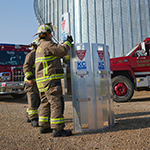Safe storage of pallets and bins
Avoid fire hazards and promote effective sprinkler system control.
Indoor storage of stacked idle pallets and bin boxes presents one of the greatest challenges to sprinkler systems because they create an ideal arrangement for rapid spread of fire. This is true of both wood and plastic pallets and bins. Many managers look at indoor idle pallet storage from the perspective of operational efficiency and don’t recognize that this practice can easily overcome a typical automatic sprinkler system. The result can be devastating to a business and may include production interruption and total loss of a building.
Fire hazard and effective sprinkler system control
Wood pallets and bins dry out and their edges fray and splinter after they are used for a short time. A relatively small ignition source can cause them to catch fire in their dried-out condition. When combined with a high rate of heat release and a large amount of built-in air space, the fire can develop quickly. It is especially difficult to control or extinguish such a fire because the undersides of the pallets and bins are shielded from the discharge of automatic sprinklers, preventing water from reaching the base of the fire.
The only practical method of stopping a fire in a large concentration of pallets or bins with ceiling sprinklers is by means of prewetting. In high stacks, this cannot be done without significant water supplies. High piling considerably increases both the challenge to sprinklers and the probability of involving a large number of pallets or bins when a fire occurs.
Risk improvement opportunities or recommendations
The following recommendations have been developed for floor piled storage and do not apply to pallet or bin storage in racks, on shelves or above doors.
Store idle floor-piled pallets and bins outdoors or in a detached structure whenever possible.
Outdoor storage of wood pallets and bins
When storing wood pallets or bins outdoors, it’s important to maintain the recommended distances to buildings and storage arrangements as indicated in Table 1.
If idle wood pallets are stored inside buildings with a typical sprinkler system (control mode density area system),
- Pallets should be stacked no more than 6 feet high
- Each pallet pile of no more than 4 stacks should be separated from other pallet piles by at least 8 feet of clear space or 25 feet of commodity. (National Fire Protection Association (NFPA) 13 – Standard for the Installation of Sprinkler Systems, 2019 Edition: §12.12.1)
Outdoor storage of plastic bins
For outdoor storage of plastic bins, maintain the recommended distances to building and structures as indicated in Table 2.
If idle plastic pallets must be stored inside, the following requirements must be met:
- Pallets should be stacked no more than 4 feet high
- Each pallet pile of no more than 2 stacks should be separated from other pallet piles by at least 8 feet of clear space or 25 feet of commodity
- Protection should employ high-temperature-rated sprinklers. (NFPA 13 — Standard for the Installation of Sprinkler Systems, 2019 Edition, §12.12.2)
Atypical sprinkler systems
Other, less common types of sprinkler systems — such as Early Suppression, Fast Response (ESFR), large drop and specific application control mode — are capable of delivering greater amounts of water and may be able to protect idle pallets stored inside. Please contact the Property Engineering Group for assistance if you have any questions or unusual situations.
Pallet storage in the food industry
If food safety regulations prevent outdoor pallet storage, a dedicated storage building or a portion of an existing building may be the only available option. If storing idle pallets in a non-sprinklered building, all of the following requirements must be met:
- A dedicated room should be constructed separating the idle pallet and bin storage from the remainder of the building by UL designed 3-hour fire rated walls.
- Any equipment or personnel doors required in the 3-hour rated fire walls should be protected with UL listed self-closing fire doors commensurate with the wall fire rating.
- Approved closing devices should be provided on both sides of the wall opening in accordance with NFPA 80.
- Fire doors provided should be inspected and functionally tested on an annual basis.
There are exceptions to the amount of distance that must be between buildings and safely stored idle pallets and bins, depending on the construction of the exposed wall and the number and type of pallets or bins. Refer to Table 1 and Table 2 for guidance.
Food safety hazards
Pallet storage and use may also present possible food safety issues. Independent studies have shown that pathogens or other microorganisms can survive on pallets. Recalls have also occurred because of chemicals that were utilized to previously treat wood pallets that have contaminated the materials being stored on the wood pallets.
The following suggestions are programs and policies to consider related to storage and use of pallets to limit concern regarding possible food safety hazards.
Pallet management in the food industry
Each food manufacturer, warehouse or distributor should have a pallet management program in place. A pallet management program should consist of the following elements:
Specifications
- Both wood and plastic pallets should be clean and free of splinters, debris and pest evidence.
- Pallets that have been previously soiled with animal byproducts or waste, or used for shipping waste or chemicals cannot be used.
- Plastic pallets should be made of FDA approved resins, if necessary.
Storage — outside
- Ensure the area is adequately protected against deterioration and contamination. When possible, store pallets under overhangs or canopies.
- Store pallets in a paved or blacktopped area and keep the pallets at least six inches above the paved/blacktopped surface.
- Minimize pest (bird, insect or rodent) activity at the outside pallet storage areas.
- Be sure to inspect, clean and/or sanitize pallets before use. Refer to the cleaning and sanitizing instructions below for further details.
Storage — inside
- Keep pallets away from walls — preferably 18 inches — to allow for inspection and cleaning activities within inside storage areas. Follow inside storage recommendations for fire safety.
- Generally requires less cleaning and/or sanitization of pallets prior to use.
Pallet inspection
- When receiving empty pallets, inspect them for evidence of splinters, debris, pest evidence, as well as evidence of previous non-compatible materials (i.e., chemicals, pesticides, or soiled with animal byproducts or waste.)
- If such conditions are noted, segregate those pallets for recycling or approved cleaning or repair methods.
- Inspect pallets individually before transferring them from outside storage to inside storage or use in the warehouse or production area. Ensure pallets are in good condition. Wooden pallets that are splintered, have broken boards or loose nails must be set aside for repair or recycling.
- Establish a cleaning and/or sanitizing method to remove pests and dirt or debris. Clean is defined as ‘no debris, soil, blood, oil, leaves, etc.’ Sanitized is defined as ‘a treatment method that uses heat or chemicals to effectively reduce 99.9% of pathogens.’
- Establish a compressed air station outside of the facility to clean the pallets before they are brought inside. Sanitizing is typically conducted for plastic pallets that will be transferred to production or Ready-to-Eat (RTE) areas of the facility. Pallets must dry properly prior to movement into such areas.
Plastic pallets — internal use
- Plastic pallets utilized multiple times should be part of a Master Cleaning Schedule (MCS).
- Pallets should be inspected and cleaned and/or sanitized on a pre-determined frequency.
Wood pallets — internal use
- Inspect wood pallets for evidence of debris, splinters and overall cleanliness prior to transferring raw materials, ingredients or finished products to pallets.
- Consider inserting a cardboard slip-sheet between the wood pallet and the materials being stored on the pallet.
- Insert slip-sheets between any double-stacked pallets of food materials. If slip-sheets are re-used, they should be monitored for general condition and cleanliness.
- Do not use corrugated slip-sheets because they may harbor food debris and pest activity.
Documentation
A pallet management program should be documented with work instructions and procedures to define who is responsible for what, as well as outline expectations. All employees involved with the program should be properly trained and documented.

 >
>

 >
>
 >
>